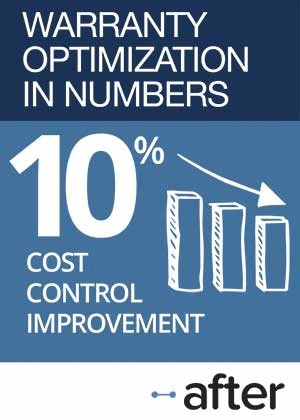July 20, 2017 |

|
ISSN 1550-9214 |
Worldwide Aircraft Warranty Report:With warranty expenses that exceed a billion dollars annually, the manufacturers of airliners, business jets, and propeller planes are a major sector within the warranty industry. And over the past decade, they have learned how to reduce warranty costs while increasing revenue, as demonstrated by their declining claims and accrual rates.The commercial aviation industry, specifically the manufacturers of the airliners, business jets, and smaller propeller-driven planes that fill our skies, are a major source of warranty expenses. Although some manufacturers are still government-owned or are closely tied to the national air forces of their countries, today most of the industry consists of publicly-traded corporations that publish their warranty expenses in their annual reports. The problem is, most isn't all. And what we're going to try to do this week is calculate a number for the entire airframe industry, including all those secretive government-owned and defense-oriented manufacturers, as well as all the small, young, and innovative family-owned or privately-held companies that aren't announcing either their annual revenues or their warranty expenses. We began the process by taking a look at what we know. Basically, there are three types of aircraft: commercial airlines, general aviation, and military aircraft. We know the most about the warranty expenses of the first group, and considerably less about the second group. The third group -- we're going to assume that military aircraft warranties, where they exist, are not reported by the manufacturers using standard metrics such as reserves, claims, and accruals. Known Warranty ExpensesSo let's see what we know first. There are basically only seven or eight manufacturers of new commercial airliners in the world today. Boeing Co. and Airbus Group N.V. are by far the largest, with annual revenues well above $50 billion. Together they accounted for nearly two-thirds of the entire worldwide airframe industry's revenue last year. However, their warranty expenses consume far less than one percent of that revenue. Next come Bombardier Inc. and Embraer S.A., from Canada and Brazil, respectively. They make many of the smaller regional jets used for commuter flights and short hops. But although their products are smaller, they spend proportionally more on warranty expenses. The French company GIE Avions de Transport Regional (ATR), is a partnership of Airbus and Leonardo S.p.A. that also manufactures regional jets, but it does not report its financials independently. However, Airbus does include some data in its annual reports on its joint ventures, and did in fact include some details about ATR under the "other businesses" heading, so we are able to create an estimate of its warranty expense and include it in our totals. China and Russia are challenging the status quo with their respective national aviation conglomerates: Aviation Industry Corp. of China (AVIC), and JSC United Aircraft Corp. (UAC). While they do not report their warranty expenses, they do report their revenues, allowing us to make some educated guesses regarding their warranty expenses. Antonov State Company, based in Ukraine, is the other remaining player in the airliner industry. Antonov has manufactured some of the world's largest cargo jets, as well as regional passenger jets and all sorts of vocational aircraft such as firefighting and crop-dusting models. However, political events on the ground seem to have derailed the company's recent production and sales, and opaque government ownership has prevented the release of even basic data such as annual revenue figures. We are going to assume that most of the company's recent revenue came from cargo plane leasing services, and little, if any, came from manufacturing of new (and warranted) units. Other commercial airline manufacturers of the past, such as McDonnell Douglas, Lockheed, Curtiss-Wright, Vickers, De Havilland, Fokker, Saab, Hawker, and Aerospatiale, have either left the business or have been acquired by one of the above companies. And then there are all the makers of bombers and fighter jets, which we're going to skip right over, because if they provide warranties at all, they're usually paid for by the buyers themselves under terms of the contract. In other words, military warranties are a bit like vehicle service contracts: completely optional and purchased separately by the customer. Warranty Expense ReportsThe largest four airliner manufacturers report their warranty expenses in their financial statements. Airbus reports in euro, but the other three report in U.S. dollars, so it's a relatively simple process to convert the Airbus numbers into dollars and derive worldwide totals for what turns out to be more than three-quarters of the industry. AVIC, ATR, and UAC are not as forthcoming, but at least we know their revenue. We should also note that Bombardier makes both aircraft and trains, and does not separate the warranty expenses of each line of business in its financial reports. Commercial airliners and business aircraft together account for only about half the company's total revenue. So there will inevitably be a bit of non-aircraft warranty expenses included in our total. However, Boeing and General Dynamics do in fact separate their military and commercial lines of business, so we won't be including any of their military revenue in our totals. AVIC and UAC don't separate their military revenue from their commercial airliner revenue, so that's also going to be included in our roundup. AVIC and UAC, in fact, are closely entwined with to their respective country's militaries (e.g. AVIC makes the Shenyang J-31 fighter, and the UAC conglomerate owns Sukhoi, makers of the Su-30MK fighter, Tupolev, makers of the Tu-95 bomber, and Mikoyan, famous for their MiG family of military aircraft). Therefore, we have a problem. For some companies, the unavoidable inclusion of military revenue (which doesn't generate traditional warranty expenses) depresses the claims and accrual rates of the whole. For other companies, the inclusion of non-aircraft revenue (which may generate proportionally higher warranty expenses) may raise the claims and accrual rates of the whole. Let's hope they cancel each other out. In 2016, the largest four airliner manufacturers -- Boeing, Airbus, Bombardier, and Embraer -- paid $645 million in claims and made $802 million in accruals, while keeping $2.55 billion in reserves. Their collective claims rate was a relatively low 0.5% while their accrual rate was 0.6% of their commercial product sales revenue. Together, they represent about three-quarters of all airframe revenue worldwide, and between 57% and 61% of the entire airframe industry's warranty expenses. General AviationAnd then there's general aviation, which is everything else that flies, but not on behalf of the world' airlines or air forces. That covers everything from sleek and fast Learjets to propeller-driven crop dusters, and actually, the vast majority of the world's daily air traffic is classified as general aviation. But the products in this category are much smaller and less expensive than the airliners, so they generate a much smaller share of the world's aviation warranty expenses. Most of the business jet makers do in fact report their warranty expenses. In fact, all four of the largest commercial airliner makers named above are also in the business jet market, as are Textron Inc. (Cessna and Beechcraft), General Dynamics Corp. (Gulfstream Aerospace Corp.), and Dassault Aviation Group (Falcon). Together, these seven companies account for upwards of 90% of all business jets sold. And they all report their warranty expenses. Put them all together and we have hard data on both the revenue and warranty expenses of upwards of 80% of the entire worldwide industry, and an even higher percentage of just the business jet segment. However, in the middle and at low end of the general aviation market, there is a noticeable shortage of warranty data of any kind. Yes, we have warranty data for Cessna and Beechcraft, but not for any of their competitors -- and there are at least 20 of them worldwide. Some of the largest general aviation manufacturers include AVIC's Cirrus Aircraft Corp. subsidiary; Austria's Diamond Aircraft Industries GmbH; Italy's Costruzioni Aeronautiche Tecnam S.r.l; Germany's Flight Design GmbH; Switzerland's Pilatus Aircraft Ltd.; France's Daher; Australia's Mahindra Aerospace; Piper Aircraft Inc. (now owned by the Sultan of Brunei); Mooney International Corp.; and CubCrafters Inc. Then there are some specialists. Quest Aircraft Co. makes planes that can take off or land almost anywhere in the wilderness. American Champion Aircraft Corp. and Extra Flugzeugproduktions und Vertriebs GmbH make aerobatic planes. Waco Aircraft Corp. makes old-fashioned biplanes. Thrush Aircraft Co. and Air Tractor Inc. make crop dusters. We will have to construct both revenue and warranty expense estimates for each of them. Textron presents another complication. First, the company's product line includes much more than just Cessna and Beechcraft. Textron also manufactures helicopters, golf carts, utility vehicles, lawn mowers, tools, and automotive parts. Textron Aviation is responsible for only about a third of the company's total revenue. Is it also responsible for only a third of Textron's total warranty expenses? Also, as we reported in the April 13 newsletter, the company recently began to report its product warranty and extended warranty expenses separately, but did so retroactively only back to 2013. But they still report only one set of company-wide warranty expenses for all their products. So inevitably, we are going to include some non-aviation warranty expenses for them as well. There's also a question of what to do about the suppliers of parts and components such as avionics and engines? Some of the largest warranty providers of all, such as United Technologies Corp. and General Electric Co., fall into this category, as do international companies such as Rolls-Royce Holdings plc. And there are many others, such as Garmin Ltd. and Rockwell Collins Inc., which provide their warranties not to the airframe manufacturer, but directly to the buyer. In other words, it's not like the passenger car industry at all, where suppliers account for only a tenth of the warranty expenses and OEMs foot 90% of the bill. In aviation, the warranties for engines, avionics, furnishings, and many other parts and components are issued directly to the buyer. For a jumbo jet, the paperwork can fill a three-ring binder. The net effect is a worldwide aviation supplier industry whose warranty expenses may equal or even exceed the size of the airframe manufacturers themselves. Within the U.S. the sales revenue and warranty expenses of the aviation suppliers does actually exceed those of the OEMs (see the April 14, 2016 newsletter for more). However, in Europe and Asia, they're frequently one and the same company, with one division supplying another division. Therefore, there's an increased mixing of both airframe and supplier revenue and warranty expenses, which external observers such as us cannot separate. In other words, this is not going to be a clean roundup of all the world's airframe-only warranty expenses. But nothing's perfect. Warranty Claims PaidLet's first look at the amount of claims paid last year by the world's airframe OEMs. Out of the top 10 manufacturers, seven reported their warranty expenses while three did not. So we will have to fashion estimates for those three (UAC, AVIC, and ATR), as well as for all the other general aviation OEMs. In 2016, claims payments by the airframe OEMs fell by about $68 million to a $1.14 billion worldwide total. We're certain of about 80% of that total, and are making estimates for the remaining 20%. In the top 10 pie chart below, Boeing comes in first with a claims total of $309 million, with Bombardier close behind with a claims total of $223 million. Using a dollar-euro conversion rate of $1.11, we're estimating that Dassault paid $115 million in claims while Airbus paid $81 million. That's the opposite of the relationship between them in terms of revenue, but this is what the companies reported. By our calculations, Dassault had a claims rate of 5.3%, while Airbus was at 0.2%. So one was unusually high while the other was unusually low. Both saw sales increases, but Dassault's claims payments rose faster than sales. Figure 1 | |||||||||||||||||||||||||||||||||||||||||||||||||||||||||||||||||||||||||||||||||||||||
| |||||||||||||||||||||||||||||||||||||||||||||||||||||||||||||||||||||||||||||||||||||||












